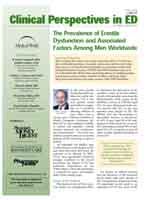Publication
Article
Generic Supplements
Clinical Perspectives in Erectile Dysfunction: Case Studies
Author(s):
C A S E 1
RT is a 56-year-old man who presents to his family physician for follow-up of hypertension control. During his history, he reports significant erectile dysfunction (ED) that has progressed over the past 8 months. This has been distressing to him and to his wife and has caused significant marital strife. He has been treated for hypertension for 4 to 5 years and is currently taking a combination of hydrochlorothiazide and atenolol with good blood pressure control. His past history includes obesity and a sedentary lifestyle. His blood pressure is moderately controlled (146/92 mm Hg). At 69 inches tall, he weighs 248 pounds.
He reports no morning erections, nocturnal erections, or spontaneous erections satisfactory for vaginal penetration. He has normal ejaculatory function without postejaculatory pain or hematospermia.
Physical examination is normal with normal genitalia, prostate examination, but a rotund abdomen that is nontender.
Laboratory studies include total cholesterol 265 mg/dL, high-density lipoprotein 38 mg/dL, low-density lipoprotein 120 mg/dL, triglycerides 270 mg/dL, and blood sugar 185 mg/dL.
Since he was not taking nitrates or alpha blockers, phosphodiesterase enzyme 5 (PDE5) inhibitors were initiated to improve his erectile function. At the same time, the patient was counseled regarding risk factors for ED. Obesity, dyslipidemia, and high blood sugars suggest that the patient is suffering from metabolic syndrome. The patient was initiated on statin treatment for his dyslipidemia and referred to a dietary controlled weight-loss program. He was encouraged to start exercising.
It was suspected that another cause of his ED was the combination of antihypertensive medications due to his hypertension. The patient was referred to his internist for further evaluation and a change in his anti-hypertensive medications from a thiazide diuretic and beta blocker to angiotensin-converting enzyme inhibitor, alpha 2 receptor blocker, calcium channel blocker, alone or in combination. Because of his ED, the patient was motivated to improve his overall risk-factor profile with the assistance of a PDE5 inhibitor as a motivational alternative. The patient and his wife were given the opportunity to seek marital counseling for further improvement in their interpersonal relationship and resolution of ED.
C A S E 2
JD is a 72-year-old man seen by his urologist for significant lower urinary tract symptoms (LUTS) with nocturia times four, urgency, frequency, but no incontinence. His international prostate symptoms score (IPSS) measured 18/3. His medical history was also significant for loss of erectile function since his LUTS had increased in severity. The patient had tried saw palmetto without relief.
The patient was also taking valsartan for hypertension control that had maintained his blood pressure in a reasonable range. He had a stable marital relationship.
Laboratory studies included normal lipid profile, blood sugar, creatinine, and prostate-specific antigen level. His hormone profile demonstrated a normal total, free, and bioavailable testosterone.
Because of his LUTS, the patient is at higher risk for ED. In an effort to improve his erectile function, the patient was begun on tamsulosin 0.4 mg each morning as well as a PDE5 inhibitor that is indicated for concomitant use with tamsulosin. His initial dose of the PDE5 inhibitor was low due to the concomitant use with tamsulosin. The patient was counseled not to take the 2 drugs within 4 hours of each other. On return, the patient noted a decrease in his IPSS score to 12/2 and felt very comfortable with his level of symptoms. His ED had improved and he was able to have adequate sexual function.







